
Vol. IV, No. 6, October/November/December 2005
- Designing Child Care Centers for Ease of Cleaning
- Mold: an Overlooked Threat to Children's Health
- Drop-Off and Pick-Up Should Be Safe
- Benefits of Children Playing Outside
- Preschool Outdoor Environment Measurement Scale (POEMS®)
- Fall = Visiting the Farm
- AblePlay™ Helps Evaluate Toys for Children with Special Needs
- Current Projects
- Child Care Design Institute for New Center Owners/Operators
Benefits of Children Playing Outside
Author's Title: Landscape as Playscape: the Effects of Natural
Environments on Children's Play and Motor Development
Author(s) Name: Inguun Fjørtoft
Year of Publication: 2004
Publisher: University of Colorado
Publication: Children, Youth and Environments
Publication Type: Refereed Journal
Date of Publication: 2004
ISSN: 1546-2250
Volume: 14 Issue: 2 Pages 21-44
Design Issue
- This study investigated the impact of playing in a natural environment on the development of motor skills of children in Norway.
- Natural environments may be more complex than designed environments; playing in natural environments may therefore require more developed motor skills.
- Children enjoy aesthetic and sensory aspects of natural environments and play more vigorously outdoors than indoors.
Design Criteria, Author identified:
- Be aware that playing in natural environments may improve motor development among children, especially balance and coordination.
- Preserve or incorporate natural environments to provide complex, stimulating playscapes for children.
- Maintain diversity in topography and vegetation to afford diverse play activities.
- Plan for natural environments to be playscapes in all seasons, affording wider opportunities for play (i.e., play on a snow-covered hill versus play on a grassy hill).
Key Concepts
- The theory of affordances (Gibson, 1979) proposed that objects in the environment provided or afforded individuals specific opportunities to act.
- In this study, “natural environment” was defined as an environment that was undesigned and uncultivated (e.g., forest). “Playscape” was defined as an environment that afforded children play opportunities (e.g., steep, smooth rocks for sliding down, loose-branched bushes for “playing house”).
- The ecological approach to development stressed that people and the environment were interconnected. Natural stimuli afforded specific opportunities for play that were not provided by designed playscapes (i.e., playgrounds).
- Children's options for play activities may have depended on
a variety of vegetation types and densities.
 High-exertion
physical activities (e.g., running, sliding, and climbing) may have
occurred most in areas of low-to-moderate tree density, while building
and role-playing activities may have taken place most in areas of greater
tree and shrub density.
High-exertion
physical activities (e.g., running, sliding, and climbing) may have
occurred most in areas of low-to-moderate tree density, while building
and role-playing activities may have taken place most in areas of greater
tree and shrub density. - Children's options for play activities may have depended on a variety of topographic qualities. Roughness and slope of surfaces afforded different play activities (e.g., sliding, skiing, or building).
Research Method
- A stratified sample (75) of children, 5 to 7 years of age, from elementary schools (3) in Telemark, Norway, were provided different play environments for one to two hours each school day for nine months. An experiment group (19 girls; 27 boys) played in a nearby forest, while two control groups (18 girls; 11 boys, total) played in traditional outdoor playgrounds with occasional visits to natural settings.
- Both groups were pre-tested in September and post-tested in May using the European Test of Physical Fitness Motor Fitness Test.
- Vegetation was described using aerial photographs for field inventory
and description. Topography (i.e., slope and roughness) was described
using contours from a municipal map and Digital Elevation Model based
analysis. A Geographical Information System (GIS) was used to analyze
and visualize landscape ecology. A differential Global Positioning System
(GPS) was used to map children's play habitats.
Vol. IV, No. 6, October/November/December 2005
- Designing Child Care Centers for Ease of Cleaning
- Mold: an Overlooked Threat to Children's Health
- Drop-Off and Pick-Up Should Be Safe
- Benefits of Children Playing Outside
- Preschool Outdoor Environment Measurement Scale (POEMS®)
- Fall = Visiting the Farm
- AblePlay™ Helps Evaluate Toys for Children with Special Needs
- Current Projects
- Child Care Design Institute for New Center Owners/Operators

